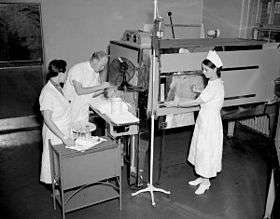Pyrotherapy
Pyrotherapy (artificial fever) is a method of treatment by raising the body temperature or sustaining an elevated body temperature (caused by a fever). In general, the body temperature was maintained at 41 °C (105 °F).[1] Many diseases were treated by this method in the first half of the 20th century. In general, it was done by exposing the patient to hot baths, warm air, or (electric) blankets and in some cases by introducing vector agents to induce the fever. Pyrotherapy was most famously used by psychiatrist Julius Wagner-Jauregg who won the Nobel Prize for Medicine in 1927 for the procedure.[2]
| Pyrotherapy | |
|---|---|
 Patient being treated with "fever therapy" in a Kettering hypertherm cabinet, U.S. Marine Hospital, New Orleans, 1937 | |
| Other names | therapeutic fever |
Use
Wagner-Jauregg’s 1917 treatment method, also known as malariotherapy, involved the introduction of Plasmodium vivax malaria via injection in to patients with advanced stages of syphilis.[2] Advanced syphilitic infection can invade the brain causing neurosyphilis, affecting neural performance and function, which can in-turn lead to general paresis of the insane (GPI), a severely debilitating mental disorder. Doing so induced high-grade (103 °F, 39.4 °C or above) fever that were easily sustainable to eradicate invading spirochaetal bacterium Treponema pallidum, the vector responsible for syphilitic infection[2][3]. Successive rounds of treatment were required to fully eradicate the infectious bacteria, while simultaneously using quinine to treat the malaria infection.[2] Management of the fevers was risky as malaria fevers can sometimes cause death, but syphilis was a proliferate and terminal disease at the time with no other viable treatment.[2] This procedure was used treat syphilis until penicillin was found to be a safer, more effective measure in the 1940s.[3]
The general paresis of the insane caused by neurosyphilis was effectively overcome by the method.[4]
Pyrotherapy was also employed in psychiatry. Of note here is the use of sulfozinum and pyrogenal that was relatively widespread in Soviet psychiatry.
Effectiveness
In 1921, Wagner-Jauregg reported impressive success and many other physicians attempting malaria induced pyrotherapy made similar claims.[5] Later analyses have shown this might not have been true since approximately 60% would relapse within 2 years and between 3% - 20% have died form the resulting fevers.[5] Significant consideration should be used here, as syphilis was considered deadly and without other treatment options pyrotherapy was a lesser of two evils.
References
- Natuurwetenschap & Techniek Magazine, october 2010
- Whitrow, Magda (July 1990). "Wagner-Jauregg and fever therapy". Medical History. 34 (3): 294–310. doi:10.1017/s0025727300052431. ISSN 0025-7273.
- Stamm, L. V. (June 2015). "Syphilis: antibiotic treatment and resistance". Epidemiology & Infection. 143 (8): 1567–1574. doi:10.1017/S0950268814002830. ISSN 0950-2688.
- Raju T (2006). "Hot brains: manipulating body heat to save the brain". Pediatrics. 117 (2): e320–1. doi:10.1542/peds.2005-1934. PMID 16452338.
- Daey Ouwens, Ingrid M.; Lens, C. Elisabeth; Fiolet, Aernoud T.L.; Ott, Alewijn; Koehler, Peter J.; Kager, Piet A.; Verhoeven, Willem M.A. (2017). "Malaria Fever Therapy for General Paralysis of the Insane: A Historical Cohort Study". European Neurology. 78 (1–2): 56–62. doi:10.1159/000477900. ISSN 0014-3022.
Bibliography
- Braslow, Joel T. (1997). Mental ills and bodily cures: Psychiatric treatment in the first half of the twentieth century. Berkeley: University of California Press. ISBN 0-520-20547-2.